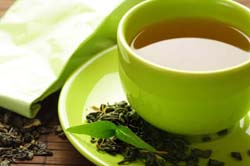
Chinese green tea is much more than a refreshing drink
Chinese green tea benefits are numerous. Most are health related, but some are cultural, especially in China – the home of green tea.
Here, people drink green tea during meals to improve digestion and dissolve oil or fat in their food, and throughout the day as a
refreshing beverage.
Green tea is offered to visitors to welcome them into their home or workplace, and it’s a common ingredient in many traditional Chinese health remedies.
Listed below are some Chinese green tea benefits, as well as common green tea uses and tips on how to make a cup of green tea.
Chinese Green Tea Benefits
According to Traditional Chinese Medicine, these are some important green tea medical benefits:
- Stops thirst
- Stimulates appetite
- Improves digestion
- Diuretic
- Clears heat from your body
- Removes phlegm
- Reduces fat
- Reduces high cholesterol
Green Tea Uses
While there are numerous Chinese green tea benefits, there are also many traditional green tea uses, not just as a drink, but as a skin wash, a mouthwash, and as an ingredient in folk remedies.
Green tea mouthwash: Trying to find green tea mouthwash to buy? The traditional way is to simply place 1-3 grams of loose green tea leaves in a cup and add hot water. When it cools, use the tea to rinse your mouth. Repeat as often as you like. Green tea cleans your teeth and prevents tooth decay and problems like gingivitis.
Green tea cleansing skin care wash: Another of the traditional green tea uses – to cleanse and cool your face and body skin. It’s also used in cases of swelling, inflammation and itching, e.g. from insect bites and sunburn. Steep 6 grams of loose or whole green tea leaves in a bowl of hot water. When cool, apply the leaves directly to the skin or use the tea water to wash the skin.
Green tea and weight control: It is generally believed in China that you can drink green tea to lose weight. For this reason it is not uncommon for thin people to be advised not to drink too much tea. Pu Er Tea from Yunnan province in China is renowned for its ability to benefit digestion, reduce fat and treat obesity. Steep 6 grams of the tea in a cup of hot water for 10 minutes. Drink throughout the day by topping up the cup with fresh, hot water as required. Cover the cup when not in use.
Green tea infusions: As mentioned, green tea is also a common ingredient in traditional Chinese medicinal teas, for example:
- Green tea and honey – constipation remedy.
- Green tea, garlic and natural brown sugar – to kill germs and resolve toxins.
- Green tea, chrysanthemum flowers and honey – for headache, dizziness and sore eyes.
Caffeine Content in Green Tea
The caffeine content in green tea depends on the type of tea, brewing time in the cup or pot, and what part of the plant the leaf is from. One cup of green tea may contain 20-40mg of caffeine – a cup of coffee may contain 100mg or more.
Unless you have a medical condition or are taking medication requiring you to limit your caffeine intake, you shouldn’t be too concerned about the caffeine content in green tea. What you should do is replace coffee (which does far more harm than good) with 3-5 cups a day of green tea. There are so many Chinese green tea benefits you’re really missing out on if you don’t drink it.
How to Make Green Tea (cup)
- Boil water (use as pure a water as possible and a non-plastic kettle) then let it cool for a few minutes.
- Place desired amount of whole green tea leaves in the cup & add a small amount of hot water. Swish the water around to wash the tea leaves, then tip it out.
- Top up the cup with hot water & let steep for 2-3 minutes before drinking.
- Re-use the leaves up to 3 times throughout the day by topping up the cup with fresh, hot water each time. Cover the cup when not in use.
With the interest in Chinese green tea benefits increasing in Western countries, more studies are being conducted to verify the traditional claims from China. Chinese people don’t need scientific proof of the benefits of green tea though – they’ve been consuming it for at least 2 thousand years, so they already know it’s good for you.
Matthew Scott is a professionally trained Traditional Chinese Medicine (TCM) practitioner from Australia, with qualifications from the Australian College of Natural Medicine, Brisbane (Acupuncture) and Zhejiang College of Traditional Chinese Medicine, China (Chinese herbal medicine).
In 2000, after 10 years in professional practice in Australia, Matthew travelled to China to continue his studies and immerse himself in the culture for a few months. He’s been there ever since!


Are the packets of Bigelow Green tea w/t Pomagranite have the same effects as raw tea leafs? Cindy really likes it.